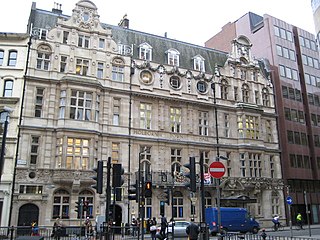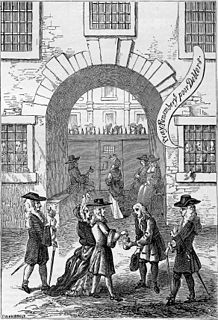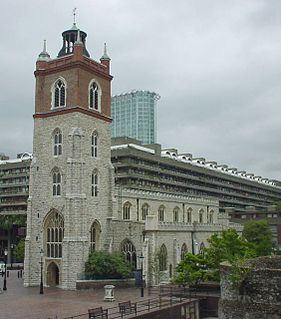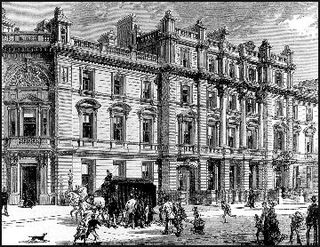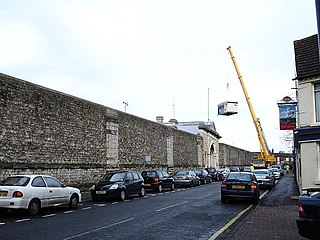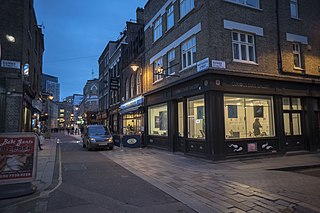This article needs additional citations for verification .(July 2016) (Learn how and when to remove this template message) |
The St Giles's Roundhouse was a small roundhouse or prison, mainly used to temporarily hold suspected criminals.

A village lock-up is a historic building that was once used for the temporary detention of people in rural parts of England and Wales. They were often used for the confinement of drunks who were usually released the next day or to hold people being brought before the local magistrate. A typical village lock-up is a small structure with a single door and a narrow slit window or opening. Most lock-ups feature a dome or spire shaped roof and are commonly built from brick, large stones or timber.

A prison, also known as a correctional facility, jail, gaol, penitentiary, detention center, remand center, or internment facility is a facility in which inmates are forcibly confined and denied a variety of freedoms under the authority of the state. Prisons are most commonly used within a criminal justice system: people charged with crimes may be imprisoned until their trial; those pleading or being found guilty of crimes at trial may be sentenced to a specified period of imprisonment.
It was located in the St Giles area of present-day central London, between Charing Cross Road and Holborn, which - during the 17th and 18th centuries - was a 'rookery' notorious for its thieves and other criminals.

St Giles is a district of London, at the southern tip of the London Borough of Camden. It gets its name from the parish church of St Giles in the Fields. The combined parishes of St Giles in the Fields and St George Bloomsbury formed the St Giles District of the Metropolis from 1855 to 1900. It is the location of the church of St Giles in the Fields, the Phoenix Garden and St Giles Circus. With Bloomsbury and Holborn, it is part of the "Midtown" business improvement district.

London is the capital and largest city of both England and the United Kingdom. Standing on the River Thames in the south-east of England, at the head of its 50-mile (80 km) estuary leading to the North Sea, London has been a major settlement for two millennia. Londinium was founded by the Romans. The City of London, London's ancient core − an area of just 1.12 square miles (2.9 km2) and colloquially known as the Square Mile − retains boundaries that follow closely its medieval limits. The City of Westminster is also an Inner London borough holding city status. Greater London is governed by the Mayor of London and the London Assembly.

Charing Cross Road is a street in central London running immediately north of St Martin-in-the-Fields to St Giles Circus and then becomes Tottenham Court Road. It is so called because it leads from the north in the direction of Charing Cross at the south side of Trafalgar Square, which it connects via St Martin's Place and the motorised east side of the square.
The Roundhouse was notable for being one of the prisons from which notorious thief Jack Sheppard escaped, in 1724. The building was converted into almshouses in around 1780. [1]

Jack Sheppard was a notorious English thief and jail-breaker of early 18th-century London. Born into a poor family, he was apprenticed as a carpenter but took to theft and burglary in 1723, with little more than a year of his training to complete. He was arrested and imprisoned five times in 1724 but escaped four times from prison, making him a notorious public figure, and wildly popular with the poorer classes. Ultimately, he was caught, convicted, and hanged at Tyburn, ending his brief criminal career after less than two years. The inability of the notorious "Thief-Taker General" Jonathan Wild to control Sheppard, and injuries suffered by Wild at the hands of Sheppard's colleague, Joseph "Blueskin" Blake, led to Wild's downfall.
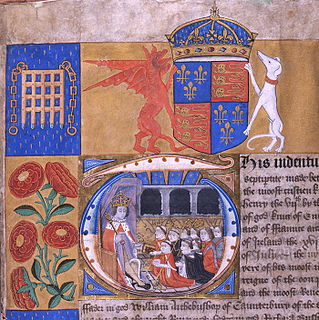
An almshouse is charitable housing provided to people in a particular community. They are often targeted at the poor of a locality, at those from certain forms of previous employment, or their widows, and at elderly people who can no longer pay rent, and are generally maintained by a charity or the trustees of a bequest. Almshouses were originally formed as extensions of the church system and were later adapted by local officials and authorities.


